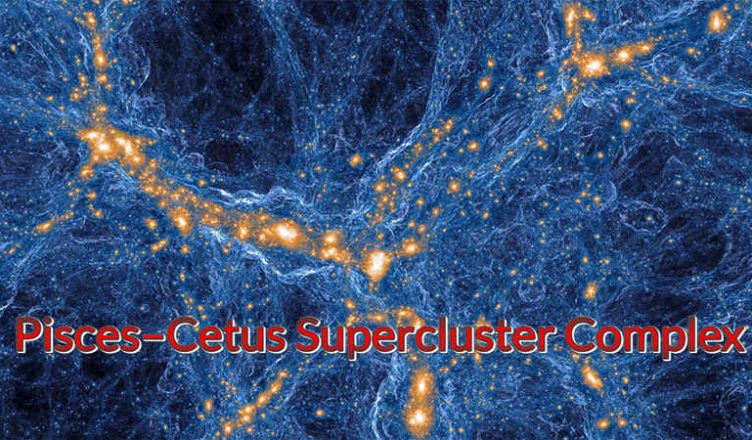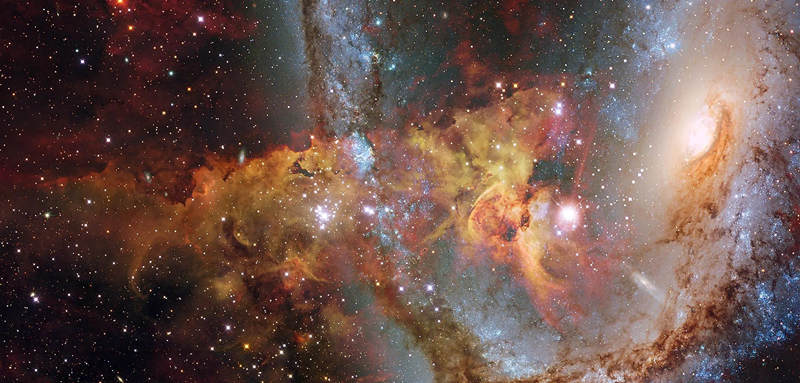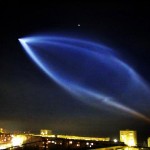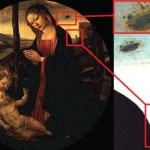In the vast expanse of the universe, galaxy clusters and superclusters resemble a cosmic tapestry woven from countless galaxies and structures. Within this cosmic weave, a mysterious structure known as the “Pisces–Cetus Supercluster Complex” is extending its tendrils across our universe. The existence of this supercluster complex was first confirmed by the distinguished astronomer R. Brent Tully of the University of Hawaii’s Institute for Astronomy in 1987. His discovery unveiled a cosmic marvel—a colossal structure accommodating multiple galaxy clusters, aptly named the “Pisces–Cetus Supercluster Complex.”
The scale of this complex is truly awe-inspiring, with an estimated length of 1 billion light-years and a width of 150 million light-years. While it ranks among the largest known structures in the universe, it still falls short in size compared to other spectacular cosmic structures such as the Sloan Great Wall, the Clowes–Campusano LQG, U1.11LQG, Huge-LQG, and the Hercules–Corona Borealis Great Wall. The Pisces–Cetus Supercluster Complex is estimated to contain about 60 clusters, with a total mass estimated to be a staggering 1*10^18 solar masses. This colossal structure is found to consist of five distinct components, each characterized by unique features and combinations of galaxies.
Foremost among these is the Pisces–Cetus Supercluster, serving as the core of this complex. Additionally, the Perseus–Pisces Supercluster of the Perseus–Pegasus Chain claims its place in this vast cosmic structure. The Pegasus–Pisces Chain, in turn, forms the Taurus Cluster and the Perseus Cluster of the Taurus Wall. Another component is the Laniakea Supercluster, encompassing our own Virgo Supercluster (the local supercluster) and the Hydra–Centaurus Supercluster. Interestingly, the naming of this breathtaking complex is derived from the most prominent Pisces–Cetus Supercluster. In comparison, our own Virgo Supercluster, although a grand structure in its own right, possesses a mass of only 1*10^16 solar masses, merely 0.01% of the total mass of the complex. The existence of this complex not only expands our understanding of cosmic structures but also beckons us to explore more of the mysterious and vast secrets the universe holds.
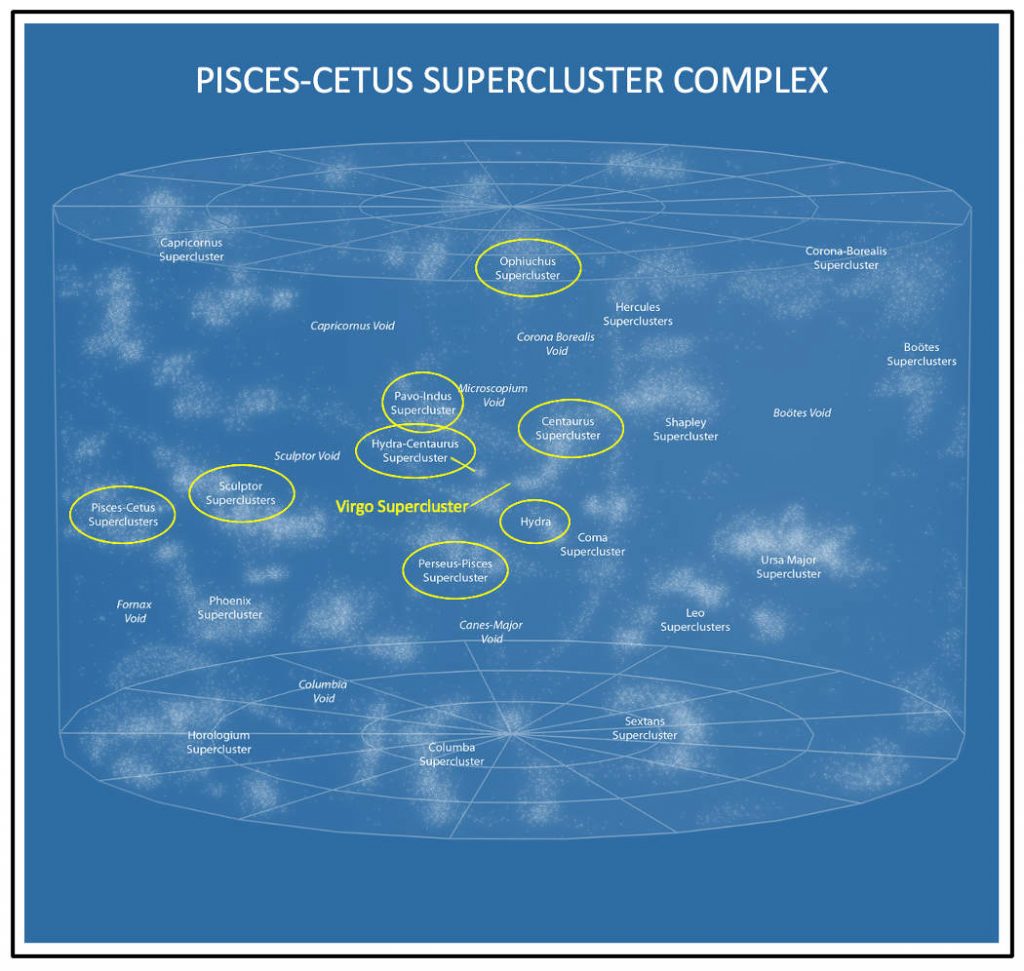
Unraveling the Cosmic Tapestry: The Enigma of the Pisces–Cetus Supercluster Complex
In the quest to fathom the vastness of the universe, humanity has grappled with an age-old mystery that instills a sense of fear—the sheer size of the cosmos. This fear stems from the unknown, much like the unease one feels in a new castle. Until this cosmic enigma is unraveled, the fear persists, akin to sleepless nights in an unfamiliar fortress.
Captured from the orbit of Saturn, Earth appears lonely from a distance of 1.5 billion kilometers.
The universe, akin to that castle, remains shrouded in mystery, evoking a sense of fear due to the unknown. To dispel this fear, humans seek to unravel the mysteries of the cosmos. Among these mysteries, understanding the size of the universe stands as the ultimate quest. However, compared to the vastness of the cosmos, humanity, Earth, and even the Sun appear minuscule.
Key Points about the Pisces–Cetus Supercluster Complex:
1. Structure of the Universe:
- The universe, like a castle, harbors the unknown, fueling human fear.
- Eliminating this fear requires unraveling the mysteries of the cosmos.
2. Comparison of Celestial Bodies:
- The universe comprises structures beyond galaxies: asteroids, satellites, planets, stars, and galaxies.
- Contrary to common belief, galaxies are not the largest structures; the complete structure includes meteoroids, satellites, planets, stars, galaxies, galaxy clusters, superclusters, supercluster complexes, and the cosmic web.
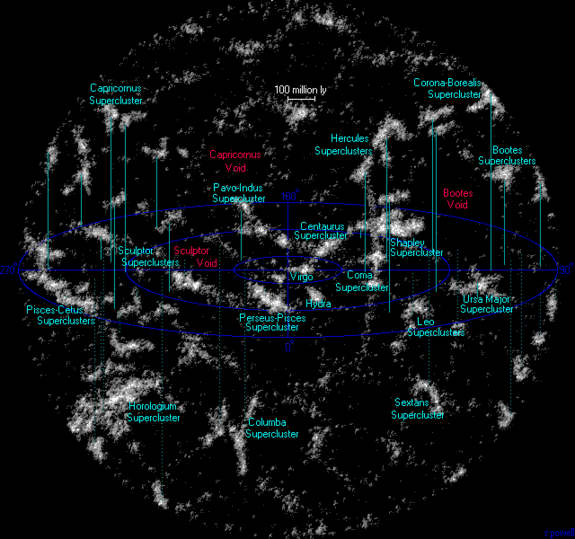
3. Sizes of Celestial Bodies:
- Our local cluster, the Virgo Supercluster, has a diameter of 10 million light-years.
- The Laniakea Supercluster, encompassing the Virgo Supercluster, boasts a diameter of 100 million light-years.
- The Pisces–Cetus Supercluster Complex, a higher-level structure, stretches across 1 billion light-years.
4. Comparison with Known Structures:
- The complexity of the universe surpasses comprehension, leading some to question the meaning of life.
- The vastness of the universe is evident in structures like the Pisces–Cetus Supercluster Complex.
5. Ultimate Cosmic Structures:
- The universe’s largest structures include supercluster complexes, such as the Pisces–Cetus Supercluster Complex.
- Beyond these, the Cosmic Great Wall, with a diameter ranging from 1 to 10 billion light-years, represents the pinnacle of cosmic scale.
In exploring the Pisces–Cetus Supercluster Complex, humanity delves into a realm that challenges the very fabric of our understanding, offering a glimpse into the extraordinary scale of the cosmic tapestry.
END:
As we unravel the enigma of the Pisces–Cetus Supercluster Complex, humanity stands on the precipice of cosmic exploration, peering into the vast unknown that stretches across billions of light-years. This colossal structure, with its intricate web of galaxies and clusters, has sparked a renewed curiosity about the cosmos and our place within it.
The future of research on the Pisces–Cetus Supercluster Complex holds tremendous promise and potential. Scientists and astronomers anticipate groundbreaking discoveries that will not only deepen our understanding of this complex but also shed light on the fundamental mysteries of the universe. Advanced telescopic technologies, coupled with innovative data analysis methods, are poised to reveal finer details about the structure’s composition, dynamics, and evolution.
As we venture further into the cosmic expanse, the Pisces–Cetus Supercluster Complex beckons us to explore the boundaries of our knowledge and imagination. Future studies may uncover connections between the complex and cosmic phenomena, contributing to a more comprehensive cosmic narrative. Moreover, insights gained from the study of this supercluster complex may have profound implications for our understanding of cosmic evolution, dark matter, and the fundamental forces shaping the universe.
In the quest to decipher the mysteries encapsulated within the Pisces–Cetus Supercluster Complex, humanity not only addresses its fear of the unknown but also embarks on a journey of intellectual enlightenment. With each discovery, we inch closer to unraveling the cosmic tapestry, leaving an indelible mark on the annals of astronomical exploration. The future holds the promise of unlocking more secrets, unveiling celestial wonders, and expanding the boundaries of our cosmic knowledge. As we gaze into the cosmic abyss, the Pisces–Cetus Supercluster Complex stands as a testament to the limitless wonders awaiting discovery in the vast cosmos.
More UFOs and mysterious files, please check out our YouTube channel: MysFiles
Is the moon artificial? Evidence Proves the Moon Was Unnaturally Formed
